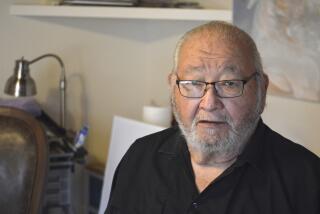Storyteller Spins Web That Captures the...
- Share via
The man struggling for life in the hospital’s intensive-care unit made but one request. He wanted his friend, David Novak, to tell him a story.
So Novak obliged, recounting the courage of a tiny spider who, against all odds, scaled a water spout after nearly drowning in a rainstorm.
“Early one morning in Spider Town, before the sun came up, all was quiet and still,” Novak began. “The cool dew was clinging to the sleepy spider webs, and not a web was stirring. . . . “
For his ailing friend, the tale of the spider “was like a warm cup of tea on a cold night,” said Novak, a professional storyteller. “It was an opportunity to hold his hand and let him know someone cared for him.”
His friend recovered, and, although Novak is reluctant to give himself credit, the episode “taught me the greatest respect for the story.”
Because his friend clung to life, the nursery rhyme “took on a great resonance and meaning. It became a real heroic journey,” said Novak, his voice becoming hushed at the memory.
Novak shares this and other tales with students throughout San Diego County. Through grants from the California Arts Council and the San Diego Institute for Arts Education, he teaches both teachers and students the joys of storytelling.
Today and Sunday at 7:30 p.m., Novak will present his “Telling Experience” at the Big Kitchen Cafe. And he will perform with other members of the San Diego Storytellers on Jan. 10 at Drowsy Maggie’s. Later this month, he will perform in Steamboat Springs, Colo., and in February will do 3 dozen performances in New York, New Jersey and Connecticut for the Lincoln Center Institute, the educational arm of the arts center.
For audiences, his tales are “like a waking dream, a guided fantasy,” said Novak, a tall man with blue eyes and a resonant voice.
“Listening to myths and legends teaches us to think in metaphors and images and to apprehend things not only in a strictly verbal way. It helps us understand life on a larger scale. We can receive life and the lessons it has to offer.”
Anne Chase, program director for the San Diego Institute, called Novak’s storytelling “exquisite. He’s enormously popular with the children,” she said, indicating that it’s unusual to hire an artist three years in a row.
Storytelling can also improve language skills.
“Before you read and write you have to speak,” said Stephanie Ruin, a fourth-grade teacher at Rose Elementary School in Escondido. “You can see the beauty of it. It’s not vocabulary and dry work sheets. It’s an expression of oneself.”
During a recent performance at Rose, Novak demonstrated that theater’s loss is storytelling’s gain. He transformed himself into an array of characters as he related the story of Little Red Riding Hood--from the cackling grandmother to the growling wolf to Little Red herself. The transformations were accomplished with the simple, clever use of a red bandanna tied around his head in various ways: under his chin for the grandmother, around his ears for Little Red and over his mouth for the wolf. At one dizzying point, he feverishly switched from wolf to Red as he chased her in a circle.
Novak also created a cozy atmosphere by enlisting the students’ help in building a “storyteller’s fire.” First, he invited listeners to throw him imaginary pieces of kindling, branches and logs. His arms sagged under the weight of the wood as he “caught” the pieces. He “lit” the wood and he and his audience began to snap their fingers as the fire sparked. Then Novak slapped his fist and clapped loudly, and the sounds of a happy crackling campfire filled the school auditorium.
Holmes Elementary School Principal Jeannie Steeg has noticed that students become enthusiastic about reading once they hear Novak’s tales.
“If he tells a story that is part of a book, kids all of a sudden want to go out and get that book,” she said. Said Rose Elementary fourth-grader Dan Claytor: “If I tell the stories to my mom, she can tell them to another kid who can tell his mom. It will spread around and keep going forever.”
Novak’s storytelling skills were honed during his childhood in Ft. Lauderdale, Fla. One of four children, he began performing in a children’s theater group in second grade.
The play was “Aladdin’s Wonderful Lamp.” “I was a spear carrier, quite literally,” said Novak, relaxing with a cup of tea in his comfortably cluttered home.
“My mother likes to tell the story of how we would visit friends and I wouldn’t want to play with the kids. I would sit with the grown-ups and play Mr. Smith. It was just an alter ego.”
Novak was also an avid reader of books by Kenneth Grahame, who writes about “mythical childhood reminiscences.”
In high school, Novak started a mime troupe that performed at other schools.
“We performed in a nudist colony once in nothing but white face,” he said with a laugh.
Novak attended Broward College in Ft. Lauderdale and transferred to Southern Methodist University in Dallas. Because of his extensive theatrical experience, he was permitted to take graduate seminars.
After his graduation in 1976 with a bachelor’s degree in fine arts, he worked briefly for theaters in Wisconsin and Rhode Island before joining the St. Louis Theater Project Company. Among his roles was the lead in Hamlet. He also fell in love with and married Courtney Flanagan, a director there whom he had met in college.
Part of his duties with the company included dressing like Paul Bunyan and spinning tall tales for schoolchildren. But Novak finally found his own voice at a St. Louis storytelling festival in 1981.
There, he used an Ed Norton-like character to tell a Japanese story about a stonecutter who was unhappy with his lot. The stonecutter used a magic potion to transform himself into an emperor, the sun, a cloud and a mountain before he realized he liked being himself best of all.
“I had an audience of 300 people and I made it up as I went along,” Novak said. “It was a real ‘aha’ experience. I suddenly discovered after all these years that I had been involved in useless yet fervent productivity.” Finally, he said, “I felt a centered-ness, a harmony.”
The story became a metaphor for his eventual realization that storytelling was his true calling.
Novak moved here to attend graduate school and earned a master’s degree in fine arts from UC San Diego in 1986. For the next two years, he endured a dizzying schedule of acting engagements from Alaska to Utah, fitting in storytelling performances with the San Diego Institute for Arts Education and the Lincoln Center Institute.
Novak flew to New York several times to audition for plays. His agent begged him to move to the Big Apple and forget his storytelling aspirations. “You should do theater and TV,” he was told. “You should be doing soap commercials.”
The uncertain life style was wearing him down. “You would be waiting by the telephone to take a job at a moment’s notice,” he said.
The final straw was a six-month stint at the Berkeley Shakespeare Festival in 1988. Even after snaring such plum roles as Troilus in “Troilus and Cressida,” he had “no notion of a future,” Novak said. He also found separations from his family difficult.
The lure of storytelling was beckoning. “I missed the autonomy, I missed the creativity and I missed the pleasure of it.”
Novak finally realized his true vocation. “With theater, I banged my head against walls, but with storytelling, doors opened that shouldn’t have. Double locks were unlocked and people invited me in.
“I finally admitted to myself that performing for children was OK,” he said. “It’s not second-best. It’s a real legitimate community which needs someone to address its interests.”
Storytelling also affords him the luxury of planning a schedule, sometimes as much as two years in advance.
Novak embroiders his stories from myth, fable and folklore. Stories also spring from his own experiences. And sometimes headlines spark stories. “Waiting for Recess” is a childs-eye retelling of the Stockton schoolyard massacre.
The best rehearsals are done in his mind. Sometimes, a story must percolate through his brain for years before it is ready to be told, he said.
Often, he weaves his story from a series of images. In the spider tale, the images were vivid. Novak described in an ominous voice how “the mouth of the spout rose up before him like a great dark cave. He could hear the wind whirring inside.” He told of “dark thunderclouds swelling up like sponges, getting ready to soak the land.” And after the rain, “water from the puddles began to steam up into the sky.”
Even in conversation, his descriptions are often lyrical. He described a theater in St. Louis as “an old ghostly edifice in the middle of a withering downtown.”
Novak likes to bring his only child, 2-year-old son, Jack, to performances. “I want to have time with him and not have a separate work world,” he said, changing a diaper after a performance. “A child brings ecstasy, joy and an unbearable promise of loss.”
Recently, Novak began weaving string images to use as illustrations for his stories.
The string once helped to unlock the memories of a timid Asian girl. Novak had asked students in a fourth-grade classroom to create their own image from string.
“She made the side of a boat and said, ‘I’m feeling sick.’ ”
“Are there other people in the boat with you?” Novak asked, then invited other students to join her.
“It turned out she was from Vietnam and she was one of the boat people. She was rescued as the boat was sinking. It made a really deep impression on me,” Novak said.
Novak recently found his life taking on a story-like quality of its own when his Australian shepherd, Gigi, bit a neighbor. The incident aroused his own feelings that somehow he wasn’t quite worthy of home ownership after leaving behind a bohemian existence.
“It was a great embarrassment to me and a source of constant chagrin,” Novak said. “I imagined the other houses glaring at us and wondered whether they had made up their minds to approve of us.”
As for the dog bite: “If this were a story, then the hero would have to face the music. So I prepared for the worst, I prepared to be humbled and make my peace with it. It turned out they were the sweetest couple, and it turned into a happy ending.”
Novak was then reminded of a Pima legend about the first human, who placed his hand over his heart and drew out a large stick.
“He used this stick from his heart to find his way in the dark, and, when he was weary, he rested on it.
“For me,” Novak said, “stories are sticks from the heart.”
More to Read
The biggest entertainment stories
Get our big stories about Hollywood, film, television, music, arts, culture and more right in your inbox as soon as they publish.
You may occasionally receive promotional content from the Los Angeles Times.










